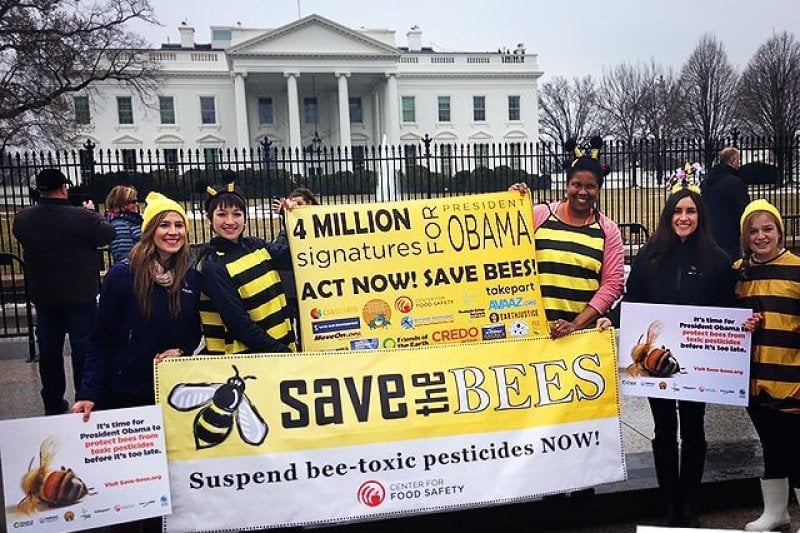George Kimbrell, Center for Food Safety legal director and lead counsel in the case against the EPA, immediately claimed that the settlement represented a massive victory in support of his claim that neonicotinoids (aka neonics) are ‘harmful, toxic’ chemicals.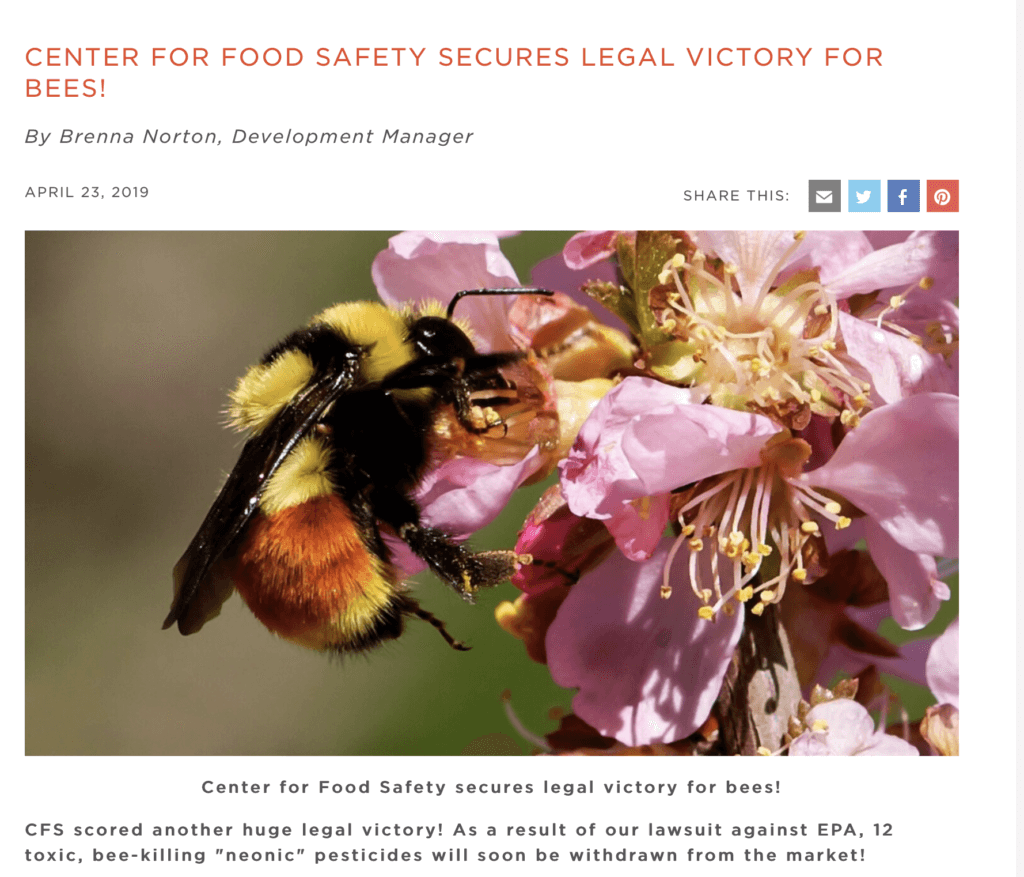
According to the post:
[The] cancellation of these …. pesticides is a hard-won battle and landmark step in the right direction,’ said …. Kimbrell …. ‘But the war on toxics continues: We will continue to fight vigilantly to protect our planet, bees, and the environment from these and similar dangerous toxins.
Unsurprisingly, CFS acolytes like Care2 crowed in its headline and blog about the success of activist groups in bringing American regulators to heel. VICTORY! EPA Cancels 12 Bee-Killing Pesticides, Care2 wrote on its social community site:
The environmentalists, food safety organizations and beekeepers spent the last 6 years holding the EPA accountable for its lack of diligence in preventing or addressing bee Colony Collapse Disorder and to demand that the EPA protect livelihoods, rural economies and the environment.
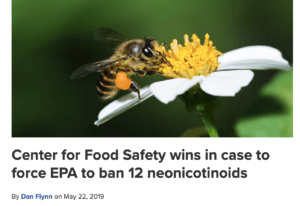 The onslaught of activist stories got the activist tort machine in gear, as ambulance-chasing attorneys with deep ties to CFS began their solicitations. Food attorney Bill Marler’s oxymoronically-named Food Safety News headlined its article: “Center for Food Safety wins in case to force EPA to ban 12 neonicotinoids.”
The onslaught of activist stories got the activist tort machine in gear, as ambulance-chasing attorneys with deep ties to CFS began their solicitations. Food attorney Bill Marler’s oxymoronically-named Food Safety News headlined its article: “Center for Food Safety wins in case to force EPA to ban 12 neonicotinoids.”
Claims that bees and our planet are endangered by ‘dangerous toxins’ aside—we will address that—Kimbrell’s casting of the court agreement as a victory for anti-pesticide campaigners almost immediately became the narrative angle parroted by much of the mainstream media. According to reports that flooded the Internet, many sprinkled liberally with claims from CFS, the EPA had moved to ‘ban’ a class of insecticides that environmental activists blame as the key driver of bee health problems.
[Read the GLP profile on the Center for Food Safety]
Most media outlets apparently didn’t even bother to contact the EPA to find out what in CFS’s news release was accurate and what was self-serving spin. Business Insider’s Aria Bendix told readers, The US just banned 12 pesticides that are like nicotine for bees. Bloomberg reported, EPA Curbs Use of 12 Bee-Harming Pesticides. According to Washington Post energy reporter Dino Grandoni,”EPA now blocks a dozen products containing pesticides thought harmful to bees. The respected publication The Scientist headlined its article, EPA Cancels Registrations for 12 Neonicotinoid Pesticides, noting in the first line:
Out of concern for bees, the Environmental Protection Agency announced on May 20 that the registrations for 12 neonicotinoid-based products used as pesticides in agriculture would be canceled…
What did the EPA say and do
Not one of those articles, or dozens of others that popped up on news sites across the world, accurately represented what the EPA actually said or the actions that it took. The EPA brokered a settlement between activists and companies that manufactured the pesticides: Syngenta, Valent and Bayer. As the agency noted to the GLP in an email, this action amounted to a voluntary withdrawal; there was no ‘cancellation’ initiated by EPA and no ‘blocking’ of products as has been widely claimed. The EPA also rejected the claim made by Kimbrell that the 12 named neonicotinoid insecticides pose significant harm to bees as The Scientist and many other media outlets claimed; in fact in an email exchange with the Genetic Literacy Project, the agency took pains to underscore that no research supported that allegation.
There are two approaches for cancelling pesticide registrations under federal law: voluntary cancellation of a pesticide product or use and pesticide cancellation under EPA’s own initiative. Voluntary cancellations are by far the most common. Cancellation under EPA’s own initiative [which did not occur in this case] begins when the Agency has identified unreasonable adverse effects from registered uses, and the registrants have not made necessary changes (to the extent changes are possible) to the terms and conditions of the registration to address the unreasonable adverse effects. EPA has not identified unreasonable adverse effects associated with the 12 voluntarily cancelled products.
Biased or botched representations from fringe environmental groups is standard operating practice. That’s not surprising. After all, professional protestors often promote an ideological agenda even if it conflicts with science. They sometimes do get the science right. Often their bottom line is whether its position on an issue serves its institutional interests, helps with fund raising or otherwise stirs its activist base.
The most disappointing twist in this sad tale is that Kimbrell’s spin spurred many reputable journalists and globally respected news organizations to fumble the story, acting more like enablers rather than skeptical inquirers with a commitment to truth, ideology be damned. Perhaps we are pinning for ‘old school’ journalism. In this case, many reporters simply parroted the claims in news releases sent out by anti-pesticide ideologues, such as CFS, distorting what the EPA and the presiding judge actually decided in this case.
Self-celebratory comments from Kimbrell aside, an expensive multi-year court battle initiated by environmental activists to try to force the EPA to ban or heavily restrict neonicotinoids on the basis of their alleged harm ended with a whimper—an affirmation by the judge in the case that there is no evidence that the pesticides cause demonstrable harm. No ban was ordered. The ‘perpetrating’ companies voluntarily agreed to halt the marketing of 12 of the least used neoncotinoids that they sold in the US.
A balanced reading of the EPA’s action is that the brokered settlement was a major blow to activist anti-neonicotinoid efforts. The voluntary agreement was reached on the basis of what amounted to a technical process violation: the EPA had failed to consult other federal agencies in what is a truly byzantine process before it originally approved 59 neonic insecticides. The various companies involved in the settlement agreed to withdraw 12 of the approved neonics. Two aren’t even sold in the US and five were never commercialized. Most of the rest are barely in use. The court pointedly rejected the plaintiffs’ argument that neonics threaten pollinators. The effective impact on the companies and on farmers who rely on these insecticides: essentially zero.
How the case against the EPA targeting neonics unfolded
With the Center for Food Safety acting as point litigant, several high-profile environmental activist groups and beekeepers alleged in a 2013 lawsuit that the EPA had failed “to protect pollinators from …. the bee-killing pesticides clothianidin and thiamethoxam ….” They demanded that the agency suspend 59 products that contain either of those active ingredients. The two chemicals are part of a class of widely used insecticides known as neonicotinoids (aka ‘neonics’) that activists blame for ‘massive bee die-offs,’ what they have dubbed a ‘beepocalypse.’
[Read the GLP’s FAQ Are GMOs and pesticides threatening bees?]
The CFS and its coalition claimed that the EPA violated the Federal Insecticide, Fungicide, and Rodenticide Act (FIFRA) and the Endangered Species Act (ESA) by failing to perform full ESA effects determinations on clothianidin (CLO) and thiamethoxam (THX). The activist group demanded the agency do ‘full effects’ studies on every single product containing these two substances and suspend all products containing them until the studies were complete. If it had been ordered, such an undertaking would have required years of regulatory review and resulted in an effective ban, which is the CFS master strategy: use (or abuse) the legal system to gum up the works.

In May 2017, the court ruled for the EPA on the FIFRA claims and for CFS on the ESA claims. It ordered the parties to reach a settlement. The EPA agreed to ESA consultations by June 2022 as part of its already scheduled review since pesticides have to be periodically re-registered by law. As a result, instead of doing separate determinations for each product as the plaintiffs had demanded, EPA will more rationally do them all at once for the two active ingredients (i.e. one for CLO and one for THX). The ruling was a huge setback for CFS. Neither the courts nor the EPA backed activist group claims that neonics are especially harmful to endangered species.
Echoing comments sent to the GLP by the EPA, the judge in the most recent ruling explained that CFS “… did not identify any evidence that might show an imminent hazard existed.” Note that the
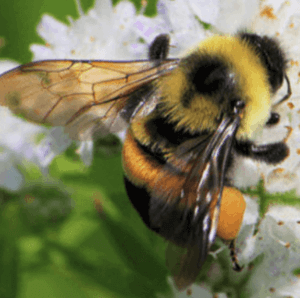
EPA subjects all pesticides to extensive testing before registering them, paying special attention to how the chemicals could impact pollinators and endangered species. Nothing presented by the coalition raised questions about this extensive review process and its findings.
The activists’ ‘success’ in this multi-year charade, as much it was, was based on a process technicality: it was determined that the EPA had failed to consult the US Fish and Wildlife Service and National Marine Fisheries Service before registering the 59 products containing the neonicotinoids clothianidin or thiamethoxam.
In fact, the 12 insecticides were eagerly agreed upon by the manufacturers because they had limited commercial value. Neonic manufacturers Bayer, Syngenta and Valent initiated the cancellations of their 12 products to facilitate the settlement; the EPA did not ‘ban’ them as various headlines have claimed.
“This notice announces EPA’s order for the cancellations, voluntarily requested by the registrants and accepted by the Agency,” as the federal regulator explained on May 20. Bayer likewise noted in a statement:
Though not defendants, Bayer and several other companies intervened in that lawsuit in defense of the critical tools involved. After court-ordered settlement talks, [in 2018] all parties reached an agreement whereby Bayer and several other companies agreed to the cancellation of a total of 12 minor registrations, all of which have little or no commercial significance.
What does the science say? NPR reporting was most egregious
From a legal perspective, the settlement was a thumping defeat for CFS and a victory for mainstream science. But with the help of credulous journalists, CFS turned an embarrassing ideological stumble into a PR victory. Most media outlets framed this story as capitulation by the EPA and major chemical manufacturers.
Coverage by one of National Public Radio’s flagship stations, WBUR, was arguably the least credible. The On Point segment, hosted by NPR’s Meghna Chakrabarti, featured Bloomberg reporter Adam Allington, and Aimee Code, a spokesperson for the environmental activist nonprofit Xerces Society. Listeners following the story online were greeted by this headline and summary when they clicked on the story:
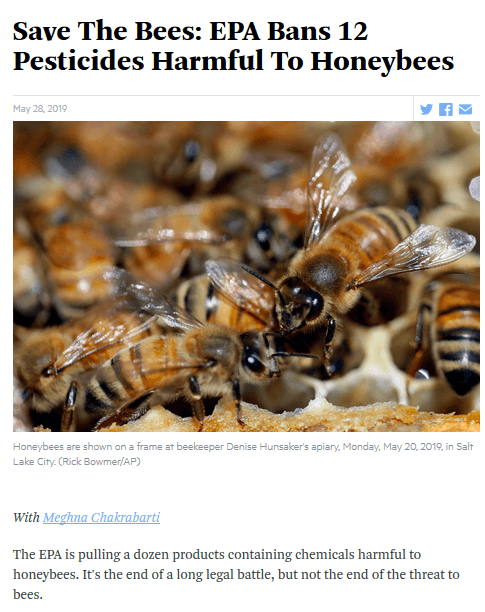
Conspicuously absent from WBUR’s ‘expert panel’ was even one entomologist or chemical expert to speak to the science of pollinator health and pesticides. Chakrabarti acted more like cheerleader than critical commentator. She frequently encouraged her two primary guests to endorse the activist case that neonics pose unique harm to bees and the environment.
Allington and Code did acknowledge that bees face a variety of threats beyond pesticides. But according to Allington, an ‘increasingly solid body of science’ backs up the campaign to ban neonics. Chakrabarti also did not challenge Code when she made her unsupported argument that “…. we have a growing body of science that is showing significant concern with these chemicals for pollinators and a number of endangered species.”
Those ‘sky-is-falling’ claims are just not accurate, according to entomologists. Many independent experts don’t even rank pesticides among the top 10 threats to pollinators. Topping the threats to bees are the virus-transmitting varroa mite. [Read GLP’s special section on Bees & Butterflies: Facts about pesticides and pollinators to learn more]
As the GLP has reported, honeybee populations are growing, including in North America, where hive numbers recently reached their highest levels in more than two decades. Bumble bees are not in danger of extinction. World beehive numbers are at an all time high.
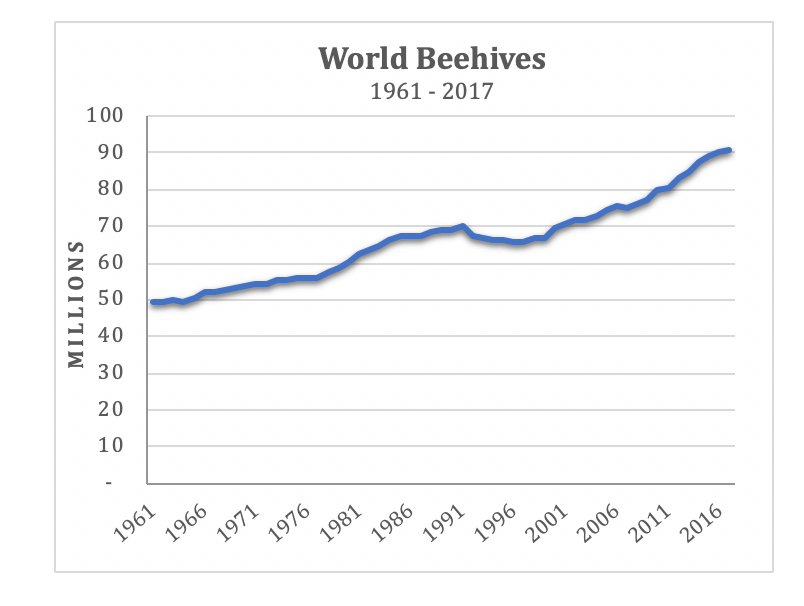
NPR did not allow for any dissident, more-science based voices. The only contrary perspective was offered by North Dakota corn and soybean farmer Carson Klosterman, who was given a few minutes to weigh in. He emphasized that neonics help control devastating pests on his farm and that bees face far more serious health threats, including from transportation over long distances. The biggest threats to bees—varroa mites, chemicals used to control them and fungi—were not mentioned.
Allington and Code wrapped up the segment by taking audience questions; Klosterman was allowed to respond to one question. Code got the last word, arguing that we need to “shift our system dramatically” by moving away from chemical pesticides and toward regenerative agriculture, which is the popular, emerging code phrase re-branding of organic farming. This transition to organic farming, if it should occur, would have no beneficial impact on bee health, as many of the ‘natural’ chemicals used to control varroa mites and fungi are actually more harmful to bees than neonics.
The imbalanced segment did serve one major purpose—to reinforce the unscientific and factually inaccurate claim by anti-pesticide advocacy groups—that, as Allington put it, the settlement “…. could pose a significant hurdle for EPA and the pesticide makers.” That’s just not accurate.
What happens next
Far from immediately banning the insecticides, the EPA determined that the manufacturers could sell their existing stock of these products until May 2020. EPA also said retailers can sell these insecticides until supplies are exhausted. “Consequently …. farmers are likely to have access to these twelve products for another year or two,” attorney and GLP board member Drew Kershen noted in an email to the GLP.
The settlement also included a joint notice of ‘dismissal with prejudice,’ which means the activist groups cannot bring these particular claims in perpetuity; the litigation is fully resolved. The plaintiffs also agreed not to bring litigation of any kind involving CLO or THX for five years. In sum, the case will not prevent US farmers from utilizing neonics, and that is unlikely to change even after the EPA performs the effects studies.
CFS’ press release mentioned none of these key aspects of the settlement. The Washington Post, Bloomberg and WBUR acknowledged that the cancellations were voluntary, but did not contextualize any of these other important details. Only a few news outlets grasped the flimsy nature of the CFS ‘victory’.
One of the other plaintiff’s in the lawsuit, Beyond Pesticides, had a more sober take than did CFS of what 6 years of expensive litigation accomplished: Activists got in the settlement far less than what they had wanted—”a compromise solution with, at best, weakly protective impacts”.
With the help of a compliant media, however, CFS will continue to pursue its scientifically and ethically challenged PR strategy, one that has become the norm in the highly politicized media world that we now live in: Lies are recast as truth and losses are declared ‘landmark’ wins. Asserted enough times and echoed by sympathetic commentators in a shared ideological media bubble, this strategy might just continue to yield huge, if cynical, dividends.
Cameron J. English is the GLP’s senior agricultural genetics and special projects editor. Follow him on Twitter @camjenglish
Jon Entine is the executive director of the Genetic Literacy Project. Follow him on Twitter @JonEntine

